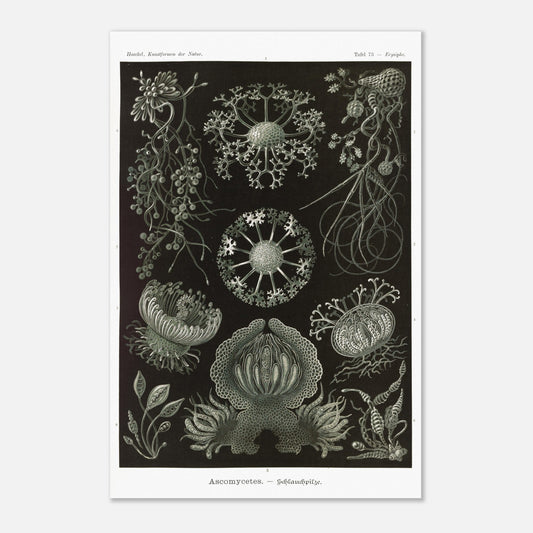Ascomycetes - Naturalist engraving - Ernst Haeckel, Kunstformen der Natur
Ascomycetes - Naturalist engraving - Ernst Haeckel, Kunstformen der Natur
Couldn't load pickup availability
Reproduction engraving of: Ascomycetes
Original title Ascomycetes - Schlauchpilze
Poster of Erysiphe - Fungi of the class Ascomycetes or Ascomycetes, Legion of Carpospores
Illustration from the book Kunstformen der Natur, which is a collection of artistic lithographs of natural sciences published by the German biologist Ernst Haeckel between 1899 and 1904.
This naturalistic illustration is part of an overall style inspired by Ernst Haeckel, which greatly influenced the emerging Art Nouveau movement at the beginning of the 20th century. This work, illustrating the impressive beauty and great diversity of the biological world, was complemented by a certain amount of scientific information, some excerpts of which are reproduced below.
This information is over 120 years old and some of it may be outdated!
Scientific classification:
Phylum of fungi (Fungi or Mycetes) Class Ascomycetes (Ascomycetes or Ascodiomycetes) Legion of Spore Capsule Mushrooms (Carpascodii)
Scientific notice (extract) accompanying the poster print of Ascomycetes - Ascomycètes :
The two great classes of fungi are distinguished by the fact that, in the basidia fungi (Basidiomycetes, Plate 63), the spores or reproductive cells arise by budding from a mother cell (Sporometra) and lie freely on the basidia, while in the asci fungi (Ascomycetes) they arise by division of the spore mother cell and are enclosed in spore-bearing sacs or asci. Most of the Ascomycetes belong to the legion of Fruchtkörperpilze (Carpascodii); their spore-bearing sacs contain a limited number of spores (usually eight) and are enclosed in peculiar fruiting bodies, the capsule-like ascospores. This includes three orders, comprising more than 10,000 species; many of these are very small, often microscopic, but very important because they cause destructive diseases as plant parasites. The order of molds (Capnomycetes or Perisporiales) is characterized by completely enclosed fruiting bodies (Clistothecia); the enclosed spores are released by the decomposition of the covering. The mycelium of these parasitic fungi (the vegetative network of segmented filamentous cells, the hyphae) forms that white, cobweb-like covering on the leaves and other parts of host plants, known as downy mildew. The fruiting bodies (Fig. 1—4), visible to the naked eye as small black dots, often have very delicate shapes. The grapevine fungus (Erysiphe Tuckeri), which causes the destructive disease of the vine, belongs to this order, as do the common molds (Penicillium, Eurotium). The order of pycnid fungi (Pyrenomycetes or Peritheciales, Figs. 5—9) has an opening at the top of the fruiting bodies (Perithecia) through which spores are released. They reproduce not only by these spores, usually eight in each ascus (Fig. 5), but also by conidial spores (Conidia or Conidia), produced in indeterminate number by budding from a hyphal cell, often in the form of a chain of spores resembling a fox's tail (Sporocatena, Figs. 8 and 9). This order includes the sooty fungi, whose mycelia cover green plants with a black crust. The order of disc fungi (Discomycetes or Apotheciales) is distinguished by open, disc- or cup-shaped fruiting bodies (Apothecia). This order includes the edible morels (Morchella), the morels (Helvella) and the cup-shaped morels (Peziza).
Species present on the naturalist board of Ascomycetes - Erysiphe :
- Erysiphe berberidis
- Erysiphe alni
- Erysiphe salicis
- Erysiphe aceris
- Cucurbitaria macrospora
- Hypomyces chrysospermus
- Hypomyces asterophorus
- Melanconis umbonatata
- Pleospora herbarum
About this print
About this print
The layout and composition of this reproduction have been the subject of our greatest attention.
- Respect for the format of the original work: in order to faithfully transcribe the artist's intention, the work is not cropped/re-cut except in extreme cases (obvious imperfection, geometry problem, etc.) in which case the cropping will be as light as possible.
- The presence of white margins is sometimes necessary in order to present the work in a balanced manner.
- Each size offered has been specifically composed, therefore, the size of the white margins may vary from one print size to another. Remember to check this detail carefully!
- Print only, frame not included!
Features
Features
- Premium 200gsm matte white paper, durable and strong.
- Natural, smooth uncoated finish, silky to the touch
- FSC certified paper or equivalent certifications depending on regional availability.
- Each print is shipped in sturdy packaging, ensuring safe transport.
- Each print is printed and shipped on demand. No minimum order quantity is required.
Share !









Recently viewed products
We are listening to you
If you are looking for a specific composition, a particular layout, or any other customization need, our team is at your disposal and will do everything possible to meet your requests.
So don't hesitate to...




